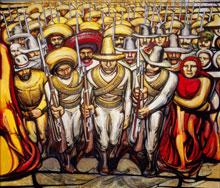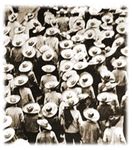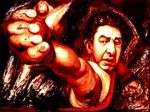|
Siqueiros was an outspoken Mexican painter and political activist during the first three-quarters of the twentieth century. He focused on important issues in his society, taking up a written, visual, and verbal “call to arms” for art to be created for and about the indigenous people of Mexico. He believed art—especially large murals—had a public purpose and duty to alleviate the problems of his “compadres.”
Read more about Siqueiros’ life before you go on.
The Mexican RevolutionIn 1910, 100 years after Mexico had declared independence from Spain, the Mexican Revolution began. Dictators had ruled Mexico for much of the nineteenth century. While the economy had improved during this time, only landowners became wealthy. Wages for workers were low, and workers, farmers, and peasants remained in poverty with little opportunity to get an education.
|
 |
 |
|
|
David Alfaro Siqueiros, From the Dictatorship of Porfirio Diaz to the Revolution—The People in Arms (detail), 1957–65 |
 |
 |
Beginning in 1910, revolutionary groups fought—often violently—to take over the government. Finally, in 1917, Mexico adopted a constitution that promised to control government power, reform education, and recognize the rights of workers. Reform would come in fits and starts during the twentieth century. In spite of economic progress, many Mexicans remain poor and undereducated today.
|
Tina Modotti, First of May or Workers Parade, 1926 |
|
|
|
The Mexican Revolution was the backdrop for Siqueiros’ teenage years. Only 14 years old when it began, he joined a revolutionary group and continued to fight for the rights of Mexican workers and the poor for the rest of his life.
|
 |
 |
|
|
David Alfaro Siqueiros, Self
Portrait (El Coronelazo), 1945 |
|



